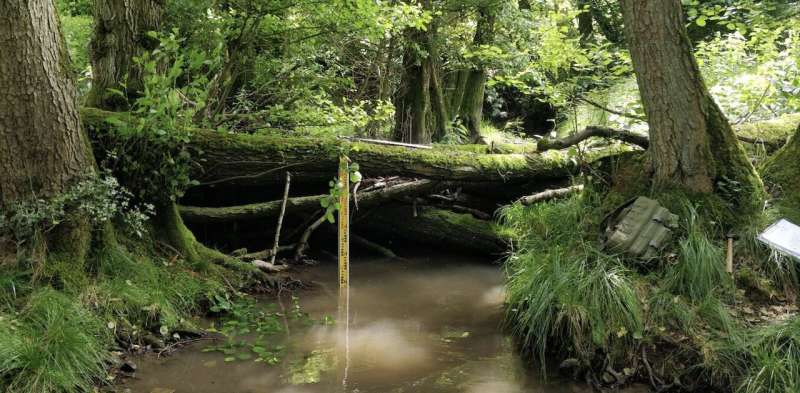This article has been reviewed according to Science X's editorial process and policies. Editors have highlighted the following attributes while ensuring the content's credibility:
fact-checked
trusted source
written by researcher(s)
proofread
Why beaver-like dams can protect communities from flooding

Low cost, human-made river barriers, similar to those built by beavers, can protect communities at risk of flooding.
Our new research has found that such natural barriers intentionally increase water levels upstream to slow down river flow. These flood barriers are made of materials like logs, branches, mud and leaves. They reduce downstream water levels by deliberately blocking the river and storing the water. They then slow down the river flow during a storm.
Using natural processes to temporarily store water above and below ground is called natural flood management. It essentially involves using nature as a sponge to soak up rainwater.
Not only does this protect communities further down the river from flooding, but it has other benefits too. It helps to enhance habitat diversity for river insects and animals, trap pollutants, and enhance the supply of sediment to the floodplain.
It also adds resilience to the river during spells of dry and hot weather by preventing it from drying up entirely. That was a big issue during the summer of 2022, which was the UK's warmest on record.
Until our recent research, very little data existed on how effective such river barriers are, or how such approaches might best be used. We also did not understand how these beaver-like dams operate during big storms.
Slowing the flow
The presence of a tree trunk or similar obstacle in a river will disrupt its flow. But the exact extent to which the water flow was slowed down by one natural barrier, let alone 50 to 100 barriers, was unknown. We also did not understand how the flow changed for different types of storms and different river settings.
The theoretical idea of a natural barrier is that they have a big hole at the bottom for everyday river flows, as well as holes in between the logs and branches in the upper part of the barrier where the water slowly flows through after a small storm.
During heavy rainfall, the water level gets higher and flows over the top of the barrier.

We found that the barrier's holes can become bigger due to the changing flow of the river. In addition, during a storm, the twigs, leaves and sediment transported by the river flow can accumulate behind the barrier, causing it to grow in size. So, we needed to understand how these natural barriers evolve over time to understand the range of their effectiveness.
Engineers use computer models called "flood models" which use mathematical equations to predict how different storm sizes impact on river water levels. These help us predict when a river will burst its banks, and then the location and extent of a flooded area.
This is important as it helps governments decide on what type of flood defense is needed to protect people from existing and future flooding. It also helps to determine where new buildings can be constructed that will be safe from flooding, and that such new builds will not make existing houses more vulnerable to floods.
The Corve catchment in Shropshire
We gathered data from 105 natural flood barriers on a small Shropshire river to measure their effectiveness in holding back flood waters and to understand how natural flood barriers operate during a storm. We collected water levels, velocity and flow data every 15 minutes for a two year period.
We also used a technique called "photogrammetry". This is where data from drone photographs are used to obtain accurate measurements of the topography in areas of river covered by trees and other vegetation.
Our results showed that the natural flood barriers at the site could store enough water to fill at least four Olympic-sized swimming pools during significant storms such as Storm Dennis, which hit the UK in February 2020.
This shows that natural barriers are effective in slowing down the flow of the river during periods of rainfall, storing up vast quantities of water which would otherwise rush through, causing damage to areas downstream. Instead, this force is slowly released over a period of one to two weeks.
Our research shows that natural flood management works. It is also cheaper than traditional engineering works and complements rather than replaces existing flood defenses.
The information from our study will help natural barriers be more accurately represented in flood models, using our new observations on barrier changes over time and effectiveness during storms.
Society can get better value from our flood defense spending by supporting landowners to install natural solutions. This is increasingly an issue as more and more houses are being built on land at risk of flooding.
Provided by The Conversation
This article is republished from The Conversation under a Creative Commons license. Read the original article.![]()


















